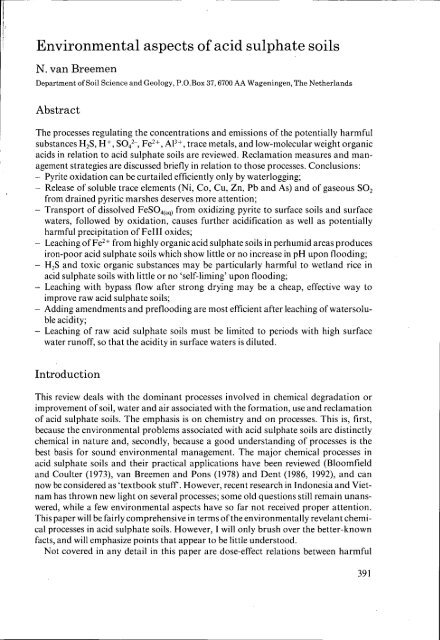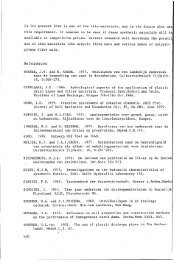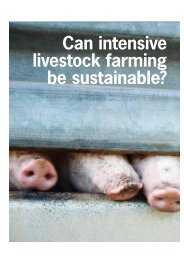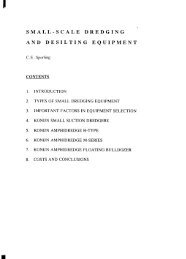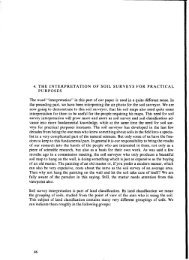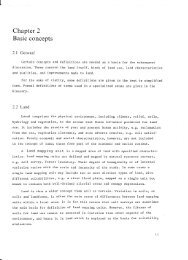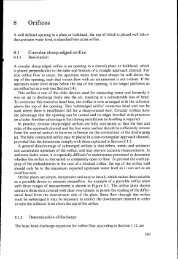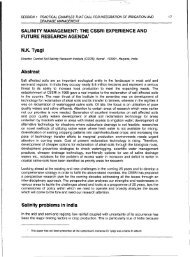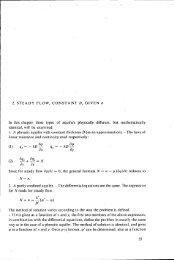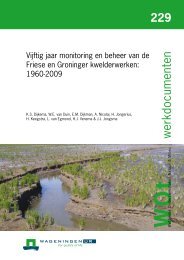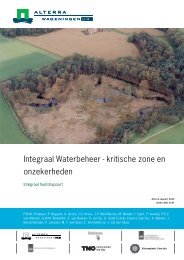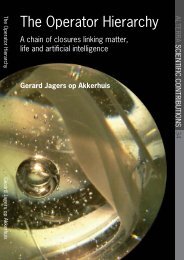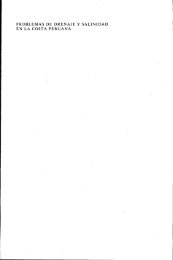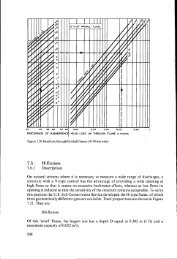Environmental aspects of acid sulphate soils - ROOT of content
Environmental aspects of acid sulphate soils - ROOT of content
Environmental aspects of acid sulphate soils - ROOT of content
Create successful ePaper yourself
Turn your PDF publications into a flip-book with our unique Google optimized e-Paper software.
June 2008Football Practice ScheduleJune 2008S M T W T F S1 2 3 4 5 6 78 9 10 11 12 13 1415 16 17 18 19 20 2122 23 24 25 26 27 2829 30July 2008S M T W T F S1 2 3 4 56 7 8 9 10 11 1213 14 15 16 17 18 1920 21 22 23 24 25 2627 28 29 30 31Monday Tuesday Wednesday Thursday FridayJun 2 3 4 5 67:30am 8:00am SR. Leadership 7:30am 8:00am SR. Leadership 7:30am 8:00am SR. Leadership 7:30am 8:00am SR. LeadershipJun 9 - 13Jun 2 - 69 10 11 12 139:00am 10:30am Fr. Workout 9:00am 10:30am Fr. Workout 9:00am 10:30am Fr. Workout 9:00am 10:30am Fr. Workout16 17 18 19 209:00am 10:30am Fr. Workout 9:00am 10:30am Fr. Workout 9:00am 10:30am Fr. Workout 9:00am 10:30am Fr. WorkoutJun 23 - 27Jun 16 - 2023 24 25 26 279:00am 10:30am Fr. Workout 9:00am 10:30am Fr. Workout 9:00am 10:30am Fr. Workout 9:00am 10:30am Fr. Workout30 Jul 1 2 3 49:00am 10:30am Fr. Workout 9:00am 10:30am Fr. WorkoutJun 30 - Jul 44/16/2008 11:36 AM
Release <strong>of</strong> trace metalsSeveral trace elements may accumulate together with Fe in sedimentary pyrite, eithersubstituting for Fe in pyrite (notably Ni and Co), or in related sulfides (Cu, Zn, Pband As) (Deer, Howie and Zussman 1965). These elements will be released duringpyrite oxidation. Extreme <strong>acid</strong>ification due to pyrite oxidation should also lead torelease <strong>of</strong> trace metals from other minerals. Research on the release <strong>of</strong> potentiallytoxic heavy metals during <strong>acid</strong> <strong>sulphate</strong> soil formation is rare. Satawathananont (1986)observed concentrations <strong>of</strong> water-soluble Cu, Zn, Mo, Cd, Pb, Ni and As that wereabout an order <strong>of</strong> magnitude higher in an aerated pyritic soil (pH 2.9) than in threewell-developed <strong>acid</strong> <strong>sulphate</strong> <strong>soils</strong> (pH 3.9-4.5) and one non-<strong>acid</strong> marine soil (pH 4.9)from the Bangkok Plain. Also, after incubation under controlled Eh-pH in <strong>acid</strong> oxidizedconditions for two weeks, water-soluble trace metals were higher in the pyriticsoil than in the older leached <strong>soils</strong> (Table 1). Palko and Yli-Halla (1988,1990) observedsimilar <strong>content</strong>s <strong>of</strong> total Cr, Cu, Zn, Co, and Ni in <strong>acid</strong> <strong>sulphate</strong> <strong>soils</strong> and non-<strong>acid</strong><strong>soils</strong> from Finland, suggesting that pyrite formation did not cause accumulation <strong>of</strong>heavy trace metals. Levels <strong>of</strong> soluble trace metals, however, were highest in the <strong>acid</strong><strong>sulphate</strong> <strong>soils</strong>. These data indeed suggest that pyrite oxidation and associated <strong>acid</strong>ificationmay release significant quantities <strong>of</strong> soluble trace metals.Release <strong>of</strong> + Al3Interest in the concentration <strong>of</strong> dissolved Al3+ stems from its potential toxicity toplant roots and to fish at concentrations exceeding 0.02 mg I-' to 10-50 mg I-', dependingon variety or species and growth stage (Thawornwong and van Diest 1974, Singhet al. 1988). Virtually concurrent with the decrease in pH during <strong>acid</strong>ification frompyrite oxidation, dissolved AI is released, presumably by dissolution <strong>of</strong> clay minerals.Over a wide range <strong>of</strong> conditions in Thai <strong>acid</strong> <strong>sulphate</strong> <strong>soils</strong>, from pH below 2 in oxidizingpyritic soil in the laboratory, to pH close to 5 in old leached <strong>acid</strong> <strong>sulphate</strong> <strong>soils</strong>in the field, activities <strong>of</strong> Al3+ obeyed the relationship [A13+][S0,2-][OH-] = 17.3, suggestingcontrol <strong>of</strong> dissolved Al by equilibrium with a basic <strong>sulphate</strong> AIOHSO, (vanBreemen 1973). This relationship was confirmed for Thai <strong>acid</strong> <strong>sulphate</strong> <strong>soils</strong> (Mooreand Patrick 1991) and for Indonesian <strong>acid</strong> <strong>sulphate</strong> <strong>soils</strong> (Groenenberg 1990). It couldbe explained by equilibrium with the mineral jurbanite, A10HS0,.5H20 (Nordstrom1982). Jurbanite, however, has never been identified in <strong>acid</strong> <strong>sulphate</strong> <strong>soils</strong>. Nevertheless,the empirical relationship appears to be useful in predicting AI concentrations.Sulphate activities vary relatively little in most <strong>acid</strong> <strong>sulphate</strong> <strong>soils</strong>, so constant values<strong>of</strong> [AI3+][S0,2-][OH-] imply that the activity <strong>of</strong> Al3+ increases about tenfoldTable 1 Contents <strong>of</strong> water-soluble trace elements (mg I-') in stirred soil suspensions (200 g <strong>of</strong> soil, 800ml <strong>of</strong> water) maintained at Eh= 400 mV and pH=3.5 for two weeks. Bang Pakong is a pyriticsoil, the others are surface <strong>soils</strong> <strong>of</strong> well developed <strong>acid</strong> <strong>sulphate</strong> <strong>soils</strong>. Data from Satawathananont(I 986)Soil Zn Cu Cd Pb Cr Ni AsRangsit very <strong>acid</strong> 16 0.55 0.29 2. I 0.35 3.0 2.8Rangsit 19 0.34 0.15 I .2 0.30 4. I 2.4Mahapot 18 0.89 0.23 I .9 0.46 7.3 2. IBangPakong 42 1.12 0.75 6.6 0.69 10.5 9.9394
with a one unit decrease in pH. At pH < 4 the same relationship, approximately, holdsalso for the concentration <strong>of</strong> total dissolved Al. A roughly tenfold increase in theconcentration <strong>of</strong> dissolved AI per one unit pH decrease, indeed, follows from datapresented for <strong>acid</strong> <strong>sulphate</strong> <strong>soils</strong> by Satawathananont (1986) and by Hanhart andNi (1991) inVietnam.It remains to be seen whether [A13+][S0,2-][OH-] remains constant under evaporativeconditions, when highly soluble Al-<strong>sulphate</strong>s (alum and pickeringite) precipitate, andin <strong>acid</strong>ified surface waters. At least in open waters, Al3+ may simply behave conservatively,i.e. without regulation <strong>of</strong> its concentration by some solid phase, as shown byNordstrom and Ball (1986) for <strong>acid</strong> mine waters.Release <strong>of</strong> SO2Gaseous SO, is released during oxidation <strong>of</strong> sulphides and can be used in prospectingfor sulphide ores. The distinct sulphurous odour that can be noticed, sometimes, indrained mangrove marshes may also be attributed to SOz. There are indications from<strong>acid</strong>-base budgets for whole soil pr<strong>of</strong>iles that a very large fraction <strong>of</strong> the potential<strong>acid</strong>ity present in pyritic sediments leaves the soil in unneutralized form as SO, (vanBreemen 1976). If this were true, oxidation <strong>of</strong> pyritic sediments is a source <strong>of</strong> air pollution,and could contribute to ‘<strong>acid</strong> rain’. In view <strong>of</strong> increasing SO, emissions fromindustrial sources e.g. in South East Asia (Rohde and Herrera 1988), a study <strong>of</strong> thebackground SO, concentrations and the possible contribution <strong>of</strong> <strong>acid</strong> <strong>sulphate</strong> <strong>soils</strong>is relevant.Oxidation <strong>of</strong> Fe11The reactivity <strong>of</strong> Fe111 with pyrite (Equation 2) accounts for a high mobility <strong>of</strong> ironin zones <strong>of</strong> active pyrite oxidation, and for a failure <strong>of</strong> solid Fe111 to precipitate adjacentto pyrite, except at high pH or at exceptionally high rates <strong>of</strong> oxidation. WhereFeSO,,,, derived from pyrite (Equation 1) is transported before being oxidized to hydratedFe111 oxide, further <strong>acid</strong>ification takes place at some distance from the pyriticzoneSuch ‘delayed’ <strong>acid</strong>ification can be observed in shallower soil horizons, in pondedfields where FeSO,,,,, diffuses upward through cracks from the pyritic subsoil, in tubedrains and in open waters.Rapid oxidation <strong>of</strong> Fe2+, especially at low pH, is mainly due to autotrophic ironbacteria. In addition to <strong>acid</strong>ification, clogging <strong>of</strong> drain tubes (Bloomfield and Coulter1973) and <strong>of</strong> fish gills (Singh et al. 1988) by FeIII(hydrous)oxide may be among theunwanted effects <strong>of</strong> reaction 4.In not-too-deeply-drained, highly organic <strong>acid</strong> <strong>sulphate</strong> <strong>soils</strong> in perhumid climates,oxidation <strong>of</strong> Fe2+ according to equation 4 seems to be hampered (Konsten et al., inpreparation). Restricted oxidation <strong>of</strong> Fe2+ may be due to insufficient aeration or toprotection <strong>of</strong> Fe2+ from O, by dissolved organic substances. Leaching <strong>of</strong> most <strong>of</strong> theiron derived from pyrite would explain the formation <strong>of</strong> <strong>acid</strong> <strong>sulphate</strong> <strong>soils</strong> with littleor no mottling from Fe111 oxide or jarosite. Such iron-poor <strong>acid</strong> <strong>sulphate</strong> <strong>soils</strong>395
differ from Fe-rich <strong>acid</strong> <strong>sulphate</strong> <strong>soils</strong> in their behaviour after flooding and reduction,as discussed below.Reduction processesReduction <strong>of</strong> redox elements that are common in <strong>soils</strong>, such as Fe, Mn, S, and N,consumes protons and is responsible for the increase in pH commonly observed in<strong>acid</strong> <strong>soils</strong> after waterlogging. Increased pH upon flooding is the main reason whywetland rice cultivation is succesful on <strong>acid</strong> <strong>sulphate</strong> <strong>soils</strong>. While the increase in pHand associated decrease in dissolved Al3+ are favourable for the crop, other changesfollowing reduction are not. These include the formation <strong>of</strong> other potentially toxicsubstances, such as Fe2+, organic <strong>acid</strong>s and HzS, in the course <strong>of</strong> soil reduction. Moreover,soil reduction or pH increase following soil reduction are <strong>of</strong>ten limited in <strong>acid</strong><strong>sulphate</strong> <strong>soils</strong>.Reduction <strong>of</strong> Fe111 and its chemical consequencesIn most moderately <strong>acid</strong> <strong>soils</strong> (pH 4-6), waterlogging causes an increase in pH to avalue between 6 and 7 after several weeks <strong>of</strong> flooding. Usually, reduction <strong>of</strong> Fe(ll1)to Fe(I1) is quantitatively the most important process involved in this rise in pH (Ponnamperuma1972, Patrick and Reddy 1978).Equation 5 illustrates that protons are consumed in the reduction <strong>of</strong> Fe(I1I) oxides,with organic matter (‘CH,O’) as the electron donorFe20~+ 1/2CH,O(,,) + 4H+(,,, + 2Fe2+Cdq) + 1/2COz,g,,,) + 5/2Hz0,,) (5)Hypothetical changes in pH and the concentration <strong>of</strong> Fe2+ upon reduction <strong>of</strong> <strong>soils</strong>with various proton donors are indicated in Figure I. In <strong>acid</strong> <strong>sulphate</strong> <strong>soils</strong>, theseprotons can be derived from free sulphuric <strong>acid</strong> and desorption <strong>of</strong> adsorbed <strong>sulphate</strong>,producing soluble ferrous <strong>sulphate</strong>, according to pathway d. In <strong>acid</strong> <strong>soils</strong> with littlefree <strong>acid</strong>ity and <strong>sulphate</strong>, hydroxylation <strong>of</strong> exchangeable Al3+ during reduction <strong>of</strong>FeIII produces Al hydroxide plus exchangeable FeZ+ (pathway a). In slightly <strong>acid</strong>to near neutral conditions, CO, may serve as a proton donor, producing HCOq plussoluble Fe2+ (pathway c), part <strong>of</strong> which may be exchanged for other cations (pathwayb). The increase in pH and in the concentration <strong>of</strong> dissolved Fe2+ stops when saturationwith ‘Fe(OH),’ has been reached. By that time, <strong>acid</strong> <strong>sulphate</strong> <strong>soils</strong> have a somewhatlower pH and much higher levels <strong>of</strong> dissolved Fe2+ (pathway d-c) than <strong>acid</strong> ‘non<strong>sulphate</strong>’<strong>soils</strong> (pathway a-c), and than slightly <strong>acid</strong> <strong>soils</strong> with appreciable amounts<strong>of</strong> exchangeable bases (pathway b). Sulphate reduction, which may follow reduction<strong>of</strong> FeIII, produces HzS and HCO). This causes a further increase in pH but tendsto decrease dissolved Fe2+ by precipitation <strong>of</strong> FeS so that, ultimately, pH and dissolvedFe in flooded <strong>acid</strong> <strong>sulphate</strong> <strong>soils</strong> may reach the same values as in ‘normal’ flooded<strong>soils</strong>.In most moderately <strong>acid</strong> wetland rice <strong>soils</strong>, the pH rises to equilibrium values between6.5 and 7 within a few weeks <strong>of</strong> flooding. The same is true for many very young<strong>acid</strong> <strong>sulphate</strong> <strong>soils</strong>, where an increase in pH from 3-3.5 to 5.5-6 is associated with‘Fe(OH)2’ is a proxy for the unknown Fell-containing hydroxide precipitates which form the bulk <strong>of</strong>solid Fe11 in most seasonally-reduced <strong>soils</strong>, with an apparent solubility product <strong>of</strong> about (van Breemenand Moormann 1978)396
1 o3[Fe2’]mg.1-‘1 o210’I I I4 5 61 iPH..Figure 1 Hypothetical changes in the concentration <strong>of</strong>dissolved Fe2+ and pH in the course <strong>of</strong> soil reduction(van Breemen.1988). Dotted lines refer to H2S concentrations (mg 1-’) in equilibrium with Fe2+.Maximum concentrations Fe2+ are determined by the solubility <strong>of</strong> ‘Fe(OH)2’, as indicated bythe bold line. .Different arrows refer to different proton donors (exchangeable Al, CO2 andadsorbed SO4), with and without formation <strong>of</strong> exchangeable Fe2+, as follows:a FeOOH + 1/4CH@ + 2/3 Al3+(,,,,) + 1/4H2O +Fe2+(exctq + 2/3AI(OHh(s) + 1/4co2b FeOOH + 1/4CH20 + 7/4C02 + M2+(,,,h) + 1/4HzO +Fe2+(,xdlj + M2+(,,) + 2HC03-(,,)c FeOOH + 1/4CH20.+ 7/4co2 + 1/4H20 +Fe2+(,,) + 2HC0-3(,,)d FeOOH + 1/4CH20 S042-c,d,j + 1/4H20 +Fe2+(,,) + + 1/4co2 + 20H-(,dS)a steep rise in dissolved Fe2+. In most older <strong>acid</strong> <strong>sulphate</strong> <strong>soils</strong>, however, the pHincreases very slowly after waterlogging and, sometimes, does not reach the valuesbetween 5.5 and 6.5 indicated in Figure I (Ponnamperuma 1972, van Breemen 1976).The reasons for this behaviour have not been studied explicitly. A slow rise in pHcan be attributed to (i) slow reduction or (ii) appreciable reduction (fermentation)in the absence <strong>of</strong> inorganic reducable substances, e.g Fe111 oxides (Ponnamperuma1972, van Breemen 1976, Munch and Ottow 1982). In case (i), neither Eh nor pHwill change much after flooding. In case (ii), the Eh will drop without concomittantincrease in pH. Slow reduction has <strong>of</strong>ten been observed, and has been attributed toa low <strong>content</strong> <strong>of</strong> metabolizable organic matter (Kawaguchi and Kyuma 1968, Ponnamperuma1972, Van Breemen 1976), and/or to adverse effects <strong>of</strong> low pH, high dissolvedAI, and poor nutrient status on the activity <strong>of</strong> anaerobes (Kawaguchi andKyuma 1968, van Breemen 1976). The strong reduction, and associated increase inpH upon flooding <strong>of</strong> very young <strong>acid</strong> <strong>sulphate</strong> <strong>soils</strong>, suggests that the presence <strong>of</strong>relatively undecomposed organic matter from the original mangrove vegetation and397
high nutrient status may be more important for strong reduction than a low pH byitself.Some <strong>acid</strong> <strong>sulphate</strong> <strong>soils</strong> in Kalimantan, Indonesia, show or no increase in pH afterreduction following flooding. This has been attributed to low <strong>content</strong>s <strong>of</strong> Fe111 oxidesrelative to the base neutralizing capacity <strong>of</strong> the soil (mainly exchangeable <strong>acid</strong>ity associatedwith organic matter) (Konsten et al., in prep.). Apparently, the combination<strong>of</strong> highly organic parent material and perhumid climate limits oxidation <strong>of</strong> Fe11 andaccumulation <strong>of</strong> appreciable quantities <strong>of</strong> Fe111 oxides and jarosite. This would explainwhy the <strong>acid</strong> <strong>sulphate</strong> pr<strong>of</strong>iles typical <strong>of</strong> monsoonal climates, with horizons <strong>of</strong> accumulation<strong>of</strong> Fe111 oxide and jarosite at increasing depth as <strong>soils</strong> become older (van Breemenand Pons 1978), are lacking in Kalimantan, as well as in other highly organic<strong>acid</strong> <strong>sulphate</strong> <strong>soils</strong> perhumid climates. The strong leaching <strong>of</strong> iron thus appears tohave important consequences, agronomically as well as for soil genesis.Reduction <strong>of</strong> <strong>sulphate</strong> and fermentation reactionsSulphate reduction also consumes protons and helps to increase soil pHSulphate reduction is generally absent or very slow at pH values below 4 to 5 (BaasBecking et al. 1966, Connell and Patrick 1966, Nhung and Ponnamperuma 1966).Yet <strong>sulphate</strong> reduction <strong>of</strong>ten occurs in waterlogged young <strong>acid</strong> <strong>sulphate</strong> <strong>soils</strong>, andupon prolonged flooding in older <strong>acid</strong> <strong>sulphate</strong> <strong>soils</strong>. In <strong>acid</strong> <strong>sulphate</strong> <strong>soils</strong>, <strong>sulphate</strong>reduction is, probably, mainly a very local phenomenon, e.g. immediately adjacentto concentrations <strong>of</strong> fresh decomposing organic matter (Hanhart and Ni 1992). H2Sis highly toxic: O. 1 mg I-' <strong>of</strong> H,S may be toxic to rice in water culture (Mitsui 1964).Amorphous Fes probably regulates the concentrations <strong>of</strong> H2S in flooded <strong>soils</strong> (vanBreemen and Moorman 1978). Fig. 1 shows that high concentrations <strong>of</strong> both H2Sand Fe2+ can coexist in the presence <strong>of</strong> Fes at relatively low pH, which illustratesthe potential danger <strong>of</strong> <strong>sulphate</strong> reduction in <strong>acid</strong> <strong>sulphate</strong> <strong>soils</strong>. Hanhart and Ni (1992)attributed the positive effect <strong>of</strong> regular shallow drainage <strong>of</strong> <strong>acid</strong> <strong>sulphate</strong> <strong>soils</strong> thathad been flooded for a long time to the oxidation <strong>of</strong> H2S.A number <strong>of</strong> organic <strong>acid</strong>s that form by fermentation in highly organic flooded<strong>soils</strong> can be harmful to rice at concentrations in the order <strong>of</strong> 0.1-1 mmo1 I-'. Highconcentrations <strong>of</strong> reducing organic substances are common in peaty <strong>soils</strong> and chemicallypoor, sandy <strong>soils</strong> low in active iron, where the pH stays low after flooding (Okazakiand Wada 1976). Possibly, such substances are important, too, for rice growingon <strong>acid</strong> <strong>sulphate</strong> <strong>soils</strong> with a low pH during flooding.Measures to decrease <strong>acid</strong>ificationCurtailing pyrite oxidationPyrite oxidation can be decreased by limiting the supply <strong>of</strong> O2 or by influencing therate <strong>of</strong> one or more <strong>of</strong> the intermediate steps in pyrite oxidation. For example, oxidationrates can be limited by decreasing the concentration <strong>of</strong> Fe3+, so that reaction2 is hampered. Pulford et aL(1988) slowed down oxidation <strong>of</strong> pyrite in coal mine wastein the laboratory by (i) decreasing the rate <strong>of</strong> oxidation <strong>of</strong> Fe2+ to Fe3+ (through398
Breemen, N. van 1976. Genesis and soil solution chemistry <strong>of</strong> <strong>acid</strong> <strong>sulphate</strong> <strong>soils</strong> in Thailand. Agric. Res.Rep. 848, Pudoc, WageningenBreemen, N. van 1987. Effects <strong>of</strong> redox processes on soil <strong>acid</strong>ity. Neth. J. Agric. Sci. 35,271-279Breemen, N. van 1988. Effects <strong>of</strong> seasonal redox processes involving iron on the chemistry <strong>of</strong> periodicallyreduced <strong>soils</strong>. In J.W.Stucki et al. (editors) Iron in Soils and Clay Minerals, D Reidel Pub1 Co, Dordrecht797-809Breemen, N. van, and F.R. Moorman 1978. Iron-toxic <strong>soils</strong>. In: International Rice Research Institute:Soils and Rice. Los Baños 781 -800Breemen, N. and L.J. Pons 1978. Acid <strong>sulphate</strong> <strong>soils</strong> and rice. In: International Rice Research Institute:rice and <strong>soils</strong>. Los Baños 739-761Brinkman, R. and L.J. Pons 1968. A pedogeomorphological classification and map <strong>of</strong> the Holocene sedimentsin the coastal plain <strong>of</strong> the three Guyanas. Soil Survey Papers 4, Soil Survey Inst. WageningenConnell, W.E. and W.H. Patrick 1969. Sulphate reduction in soil: effect <strong>of</strong> redox potential and pH. Science159,86-87Deer, W.A., R.A. Howie and J. Zussman 1965. An introduction to the rock forming minerals. Longmans,LondonDent, D.L. 1986. Acid <strong>sulphate</strong> <strong>soils</strong>: a baseline for research and development. Publ. 39, InternationalInstitute for Land Reclamation and Improvement, WageningenDent, D.L. 1992. Reclamation <strong>of</strong> <strong>acid</strong> <strong>sulphate</strong> <strong>soils</strong>. Adv. Soil Science 17,79-122. Springer Verlag, New YorkDost, H. editor 1973. Acid <strong>sulphate</strong> <strong>soils</strong>: proceedings <strong>of</strong> the international symposium, Wageningen. Publication18, International Institute for Land Reclamation and Improvement, WageningenDost, H. editor 1988. Selected papers <strong>of</strong> the Dakar symposium on <strong>acid</strong> <strong>sulphate</strong> <strong>soils</strong>. Publication 44, InternationalInstitute for Land Reclamation and Improvement, WageningenGroenenberg, J.E. 1990. Modeling <strong>of</strong> solute transport and chemical processes in <strong>acid</strong> <strong>sulphate</strong> <strong>soils</strong>. In:AARD & LAWOO: Papers Workshop on Acid Sulphate Soils in the Humid Tropics, Bogor: 182-194Hamming, A.F.J., Kasdi Subagyono, and Tagus Vadari 1990. Soil permeability <strong>aspects</strong> in Pulau Petak,Kalimantan. In: AARD & LAWOO: Papers Workshop on Acid Sulphate Soils in the Humid Tropics,Bogor: 295-332.Hanhart, K. and Doung Van Ni 1991. The effect <strong>of</strong> water management treatments on the cultivation <strong>of</strong>an irrigated dry season rice crop on a severe <strong>acid</strong> sulfate <strong>soils</strong> in Hoa An Station, Viet Nam. VH IOReprt, in prep.Holst, A.F. van and G.J.W. Westerveld 1973. Corrosion <strong>of</strong> concrete foundations in (potential) <strong>acid</strong> <strong>sulphate</strong><strong>soils</strong> and sub<strong>soils</strong> in the Netherlands. In H.Dost (ed.) Acid <strong>sulphate</strong> <strong>soils</strong>. Proceedings <strong>of</strong> the internationalsymposium Wageningen. Publication 18,11, 373-382, International Institute for Land Reclamation andImprovementKamerling, E. 1974. Bodemfysisch en agrohydrologisch onderzoek in de jonge kustvlakte van Suriname.Versl. Landb.k. Onderz. 825. Pudoc, Wageningen.Kawaguchi, K. and K. Kyuma 1968. Fertility characteristics <strong>of</strong> the lowland rice <strong>soils</strong> in some SouthernAsian countries. Transact. 9th Int. Congr. Soil Sci., Adelaide, Intern. Soc. Soil Sci. &Angus and Robertson,vol IV, 19-31Konsten, C.J.M., N. van Breemen and Supardi Suping, I.B. Aribawa and J.E. Groenenberg. Factors limitingthe rise <strong>of</strong> pH upon flooding in <strong>acid</strong> <strong>sulphate</strong> <strong>soils</strong> used for lowland rice in Kalimantan, Indonesia (inpreparation)Mensvoort, M.E.F. van, Duang Van Ni and J. van der Schans 1991. Improvement <strong>of</strong> <strong>acid</strong> <strong>sulphate</strong> <strong>soils</strong>by leaching with salt or brackish water. In: P.Deturck and F.N.Ponnamperuma (editors). Rice productionon <strong>acid</strong> <strong>soils</strong> <strong>of</strong> the tropics. Inst. Fundamental Studies, Kandy p 219-224Mensvoort, M.E.F. van, and Le Quang Tri 1988. Morphology and genesis <strong>of</strong>actual <strong>acid</strong> sulfate <strong>soils</strong> withoutjarosite in the Ha Tien Plain, Mekong Delta, Viet Nam. In H.Dost 1988. 11-15Mitsui, S. 1964. Inorganic nutrition, fertilization and soil amelioration for lowland rice. 2nd ed. Yokendo,TokyoMoore, P.A. and W.H. Patrick 1991. Aluminium, boron and molybdenum availability and uptake by ricein <strong>acid</strong> <strong>sulphate</strong> <strong>soils</strong>. Plant and Soil 136, 171-18 IMoormann F.R. and N. van Breemen 1978. Rice: soil, water, land. IRRI, Los BañosMunch, J.C. and J.C.G. Ottow 1982. Einfluss von Zellkontakt und Eisen(II1)-Oxidform auf die bakterielleEisenreduktion. Z. Pflanzenernaehr. Bodenk. 145,66-77Nae Joung Park, Joung Sun Park and Yung Sup Kim 1971. Effect <strong>of</strong> lime on growth <strong>of</strong> rice and changesin pH, Eh, Fe2+ and AI in an <strong>acid</strong> sulfate soil. J. Korean Soc. Soil Science and Fertilizer, 4: 167-175.40 1
.Nhung, M.M. and F.N. Ponnamperuma 1966. Effects <strong>of</strong> calcium carbonate, manganese dioxide, ferrichydroxide and and prolonged flooding on chemical and electrochemical changes and growth <strong>of</strong> rice ina flooded <strong>acid</strong> <strong>sulphate</strong> soil. Soil Sci. 102,29-41Nordstrom, D.K. 1982. The effect <strong>of</strong> sulfate on aluminum concentrations in natural waters: some stabilityrelations in the system AIZO,-SO3-HzO at 298 K. Geochim. Cosmochim. Acta 46,681-692Nordstrom, D.K. and J.W. Ball 1986. The geochemical behaviour <strong>of</strong> aluminum in <strong>acid</strong>ified surface waters.Science 232,54-56Okazaki, M. and H. Wada 1976. Some <strong>aspects</strong> <strong>of</strong>pedogenic processes in paddy <strong>soils</strong>. Pedologist 20,139-150Palko, J. and M. Yli-Halla 1988. Solubility <strong>of</strong>Co, Ni and Mn in some extractants in a Finnish <strong>acid</strong> <strong>sulphate</strong>soil area. Acta Agric. Scand. 38, 153-158Palko, J. and M. Yli-Halla 1990. Solubility <strong>of</strong> AI, Cr, Cn, and Zn in <strong>soils</strong> from a Finnish <strong>acid</strong> <strong>sulphate</strong>soil area. Acta Agric. Scand. 40, I 17- I22Patrick, W.H. and C.N. Reddy 1978. Chemical changes in rice <strong>soils</strong>. In: Soils and Rice. IRRI, Los Baños361-379Ponnamperuma, F.N. 1972. The chemistry <strong>of</strong> submerged <strong>soils</strong>. Adv. Agron. 24,29-96Prokopovich, N. 1988. Engineering <strong>aspects</strong> <strong>of</strong> <strong>acid</strong> sulfate deposits in California, USA, In H.Dost (editor)Selected papers <strong>of</strong> the Dakar symposium on <strong>acid</strong> <strong>sulphate</strong> <strong>soils</strong>. Publ. 44, 49-58. International Institutefor Land Reclamation and Improvement, WageningenPulford, I.D., C.A. Backes and H.J. Duncan 1988. Inhibition <strong>of</strong> pyrite oxidation in coal mine waste. InH.Dost (editor) 1988,59-67Rohde, H. and R. Herrera (editors) 1988. Acidification in tropical countries. Scope 36. John Wiley &i SonsSatawathananont, S. 1986. Redox, pH and ion chemistry <strong>of</strong> <strong>acid</strong> sulfate rice <strong>soils</strong> in Thailand. PhD Dissertation.Louisiana State UniversitySingh, V.P., T. Poernomo and R. Brinkman 1988. Reclamation and management <strong>of</strong> brackish water fishponds in <strong>acid</strong> <strong>sulphate</strong> <strong>soils</strong>: Philippine experience. In H.Dost (editor) 1988,214-228Sterk, G. 1991. Leaching <strong>acid</strong>ity from the topsoil <strong>of</strong> raised beds on <strong>acid</strong> <strong>sulphate</strong> <strong>soils</strong> in the MekongDelta, Vietnam. Techn. Rept. no 8, EEC Project STD-Vietnam, Department <strong>of</strong> Soil Science and Geology,WAU, WageningenThawornwong, N. and A. van Diest 1974. Influence <strong>of</strong> high <strong>acid</strong>ity and aluminum on the growth <strong>of</strong> lowlandrice. Plant and Soil 41, 141-159402
Seasonally recurrent fish mortalities andulcerative disease outbreaks associated with<strong>acid</strong> <strong>sulphate</strong> <strong>soils</strong> in Australian estuariesR.B. Callinan', G.C. Fraser' and M.D. Melville2NSW Fisheries, Regional Veterinary Laboratory, Wollongbar AustraliaSchool <strong>of</strong> Geography, University <strong>of</strong> NSW, Kensington, AustraliaAbstractAcid <strong>sulphate</strong> and potential <strong>acid</strong> <strong>sulphate</strong> <strong>soils</strong> are now known to be widespread onthe coasts <strong>of</strong> Australia, particularly in northern and eastern areas. The onset <strong>of</strong> heavyrain in these areas causes a 'first-flush' run<strong>of</strong>f and drainage <strong>of</strong> phytotoxic water withproperties including low pH and high concentrations <strong>of</strong> dissolved aluminum. Thesewaters have caused massive fish kills. Recently, a new ulcerative fish disease, epizooticulcerative syndrome (EUS), has shown a pattern <strong>of</strong> seasonal recurrence in EasternAustralia also relating to these onset rains. However, the pattern <strong>of</strong> this disease'sspread through Australia and Southeast Asia strongly suggests involvement <strong>of</strong> an exoticinfectious agent. The oomycete'fungus, Aphanomyces sp. has been consistently isolatedfrom ulcers but it is unable to invade the intact skin <strong>of</strong> healthy fish. Early indicationssuggest that chemical properties associated with water draining from <strong>acid</strong><strong>sulphate</strong> soil areas cause sublethal skin damage that can allow fungal invasion. Thereis a clear spatial and temporal association between onset rains, drainage from <strong>acid</strong><strong>sulphate</strong> soil areas and outbreaks <strong>of</strong> EUS, although the details <strong>of</strong> the disease processhave yet to be established.This disease threatens a major protein resource for human consumption in the Asia-Pacific region, where population growth pressure and need for economic developmentare great.Our ongoing research intends to establish, through field and laboratory studies,the role <strong>of</strong> water quality and hydrological parameters in the pathogenesis <strong>of</strong> EUS.This will allow better management <strong>of</strong> <strong>acid</strong> <strong>sulphate</strong> soil areas, thereby enhancing sustainability<strong>of</strong> estuarine fisheries.IntroductionAcid <strong>sulphate</strong> <strong>soils</strong> and potential <strong>acid</strong> <strong>sulphate</strong> <strong>soils</strong> are widely distributed in tidalriver flood plains in eastern and northern Australia. The sulphidic layers in these <strong>soils</strong><strong>acid</strong>ify periodically under natural conditions, as in prolonged periods <strong>of</strong> dry weather,or following changes to flood plain hydrology, when backswamps and freshwaterlagoons are drainend by natural processes or human intervention.Recent studies in Australia have demonstrated probable causal relationships betweenmajor rain events, the presence <strong>of</strong> significant areas <strong>of</strong> <strong>acid</strong> <strong>sulphate</strong> soil in riverfloodplains and certain seasonally recurrent fish mortalities. Studies <strong>of</strong> epizootic ulcerativesydrome (EUS), a new disease <strong>of</strong> freshwater and estuarine fish in Australia, have403
suggested similar water quality changes may be involved in its pathogenesis.In this paper we briefly review the findings <strong>of</strong> these studies and discuss possiblemechanisms responsible for death or ulceration in fish exposed to water derived fromareas <strong>of</strong> <strong>acid</strong> <strong>sulphate</strong> soil.Seasonally recurrent fish mortalitiesA fish kill may be defined as any unusual increase in mortality and morbidity, dueto infectious or non-infectious causes, in a fish population.There have been several reports <strong>of</strong> seasonally recurrent fish kills in the Magela Creeksystem, part <strong>of</strong> the East Alligator River system in northern Australia. These fish killstypically occur during the transition from the dry to wet season, when ‘first-flush’water enters lagoons and other permanent water bodies. Brown et al. (1983) describeda major fish kill in a freshwater lagoon on Magela Creek which they attributed tohigh levels <strong>of</strong> toxic aluminum (up to 0.5 mg 1-I), a consequence <strong>of</strong> natural <strong>acid</strong>ic waterrun<strong>of</strong>f. Hart et al. (1987) studied water quality in the Magela Creek system duringa dry-to-wet season transition and found that ‘first-flush’ water flowing across thefloodplain was <strong>acid</strong>ic (pH about 4-5) with high conductivity (about 750 pS cm-’) andhigh <strong>sulphate</strong> concentrations (about 200 mg 1-I). They concluded that the source <strong>of</strong>the <strong>acid</strong>ity, dissolved salts and <strong>sulphate</strong>, as well as high concentrations <strong>of</strong> metals, particularlyaluminum, was groundwater brought to the surface by rising watertablesin <strong>acid</strong> <strong>sulphate</strong> soil areas <strong>of</strong> the floodplain.Massive fish kills following major rain events have also been associated with <strong>acid</strong>icwater and high concentrations <strong>of</strong> aluminum in major sections <strong>of</strong> the Tweed Riverin northern New South Wales. The <strong>acid</strong>ic water is derived from run<strong>of</strong>f or drainagefrom the extensive areas <strong>of</strong> potential <strong>acid</strong> <strong>sulphate</strong> soil in the floodplain. In 1987,a fish kill on the Tweed River was associated with pH values as low as 3.6 and dissolvedaluminum concentrations <strong>of</strong> 2.5 mg 1-’ in major sections <strong>of</strong> the main stream (Fraser,unpublished).Low pH, below 3-4, is directly lethal to móst fish species, causing disturbances towater and ion regulation, as well as to oxygen transport mechanisms (WendelaarBonga and Dederen 1986). However, elevated concentrations <strong>of</strong> inorganic, cationicaluminum species (less than 0.1-5 mg 1-I) are thought to be primarily responsible forinjury and death <strong>of</strong> fish in naturally <strong>acid</strong>ified waters. These increased aluminum concentrationsresult, under <strong>acid</strong> conditions, from mobilisation <strong>of</strong> aluminum from watershedminerals (Driscoll et al 1980, Langdon 1988). In <strong>acid</strong>ic water, inorganic aluminumaccumulates in, and injures, fish gills, causing reductions in enzyme activity and lethalosmoregulatory disturbances (Staurnes et al 1984, Witters et al 1990). Other waterquality attributes modify the toxicity <strong>of</strong> inorganic aluminum to fish; there is evidencethat high calcium and silicon concentrations protect fish against aluminum toxicity(Brown 1983, Ingersoll et al 1990a, Birchall et al 1989). Humic substances (the endproducts <strong>of</strong> biological degradation <strong>of</strong> organic material) are also protective, bindingaluminum in a non-toxic, organic form (Witters et al 1990).In response to toxic <strong>acid</strong>/aluminum exposure, some fish species are able to acclimatize,via physiological changes, or undergo longer-term adaptation, via genetic selection(Mount et al 1990). These workers showed, however, that exposure to a 6-day ‘pulse’404
<strong>of</strong> <strong>acid</strong> water with high inorganic, monomeric aluminum and low calcium concentrations,caused significant mortalities in brown trout fry not previously acclimatizedto these conditions. It is likely that fish exposed to <strong>acid</strong> ‘first-flush’ water in Australianrivers are similarly unprepared, and that similar toxic mechanisms operate.Epizootic ulcerative syndromeEpizootic ulcerative syndrome (EUS), known colloquially in Australia as ‘red spotdisease’, is an ulcerative skin disease affecting estuarine and freshwater fish. EUS wasfirst reported in Australia from the Burnett River on the central Queensland coastin 1972 (McKenzie and Hall 1976). Since then, seasonally recurrent outbreaks havebeen recorded in many rivers on the East coast, from northern Queensland (Rodgersand Burke 1981) to southern New South Wales (Callinan, unpublished). Outbreakshave occured in southwest Western Australia since 1983 (Pass, unpublished) and inthe Northern Territory since 1986 (Pearce 1990). Serious outbreaks <strong>of</strong> the disease havealso occurred in Southeast and South Asia during the past decade (Anon 199 I).Losses due to EUS, primarily in cultured freshwater fish, were estimated at A$2.5million in Indonesia in 1980, A$ 10.9 million in Thailand in 1982 and A$4.2 millionin Bangladesh in 1988-89. EUS costs commercial estuarine fisheries on Australia’sEast coast approximately A$ 1 .million in discarded fish annually.Studies in North America have examined the possible long-term effect <strong>of</strong> ‘ulcerativemycosis’, a disease <strong>of</strong> estuarine species similar to EUS, on fishery sustainability (Merrinerand Vaughan 1987). Results suggested that an incremental decline <strong>of</strong> 0.5 percent per year in survival <strong>of</strong> young fish over a 30-year period would result in a reduction<strong>of</strong> 60 per cent <strong>of</strong> the normal expected biomass. Loss caused by EUS in Australianestuaries have not been accurately quantified but; assumming that up to IO per cent<strong>of</strong> young fish <strong>of</strong> susceptible species die as a result <strong>of</strong> EUS outbreaks occuring onceevery 3 years, a similar long-term decline in biomass may result.The sudden appearance and pattern <strong>of</strong> spread <strong>of</strong> EUS in Australia and Asia is consistentwith the involvement <strong>of</strong> an exotic infectious agent. Studies examining possibleprimary causative roles for viruses, bacteria and metazoan parasites have, to date,produced negative results. However, in a study <strong>of</strong> the pathology <strong>of</strong> EUS, Callinanet al (1989) showed that massive invasion <strong>of</strong> the skin by oomycete fungi plays a centralrole in the induction <strong>of</strong> ulcers. Recently, Fraser et al (1992) recovered the oomycetefungus Aphanomyces sp. in apparantly pure culture from 27 <strong>of</strong> 28 early ulcers on 3estuarine fish species from 3 widely separated river systems in Australia. Histologicallyindistinguishable fungi are also consistently present in lesions <strong>of</strong> fish affected withEUS in Asia (Roberts et al 1989).These findings indicate that an Aphanomyces sp. is the causative infectious agent<strong>of</strong> EUS. However, attempts to induce typical lesions by exposing fish experimentallyto fungal spores were successful only when skin was abraded prior to exposure (Callinanand Fraser, unpublished). This finding suggests that factors other than simpleexposure to the fungus are necessary for EUS outbreaks to occur in wild fish populations.EUS outbreaks in eastern Australia typically begin about 2 weeks after periods<strong>of</strong> prolonged heavy rainfall in lower river catchments. There is a growing body <strong>of</strong>405
evidence suggesting that these outbreaks occur only when susceptible fish are exposedto both Aphanomyces sp. propagules (spores and/or hyphae) and water having specificattributes. Further, there is an association between these water quality attributes andthe presence <strong>of</strong> significant areas <strong>of</strong> <strong>acid</strong> <strong>sulphate</strong> <strong>soils</strong> in the lower floodplains <strong>of</strong>affected rivers. Such areas are known to be present in floodplains <strong>of</strong> most rivers inAustralia from which EUS has been reported.Studies on the tidal floodplain <strong>of</strong> the Richmond River system in northern NewSouth Wales have demonstrated some relationships between major rain events andseveral water quality parameters. A submersible automatic water quality data logger,programmed to measure pH, dissolved oxygen concentrations, conductivity, temperatureand depth at 15-minute intervals, was placed in a tributary <strong>of</strong> the RichmondRiver immediately downstream <strong>of</strong> a typical, drained backswamp containing significantareas <strong>of</strong> <strong>acid</strong> <strong>sulphate</strong> <strong>soils</strong>. Water quality changes associated with a major rainevent are shown in Figure 1.The low pH <strong>of</strong> the water after the rain event was probably due to <strong>acid</strong>ity leachedfrom <strong>acid</strong> <strong>sulphate</strong> <strong>soils</strong> in the catchment. The cause(s) <strong>of</strong> the low dissolved oxygenconcentrations are more difficult to explain; they may be associated with microbialdecomposition <strong>of</strong> suspended organic matter or from soil water from the active rootzone, but the clear temporal association between reductions in both pH and dissolvedoxygen concentrations suggests a common mechanism. One such mechanism involvesthe oxidation <strong>of</strong> iron IT (from pyrite oxidation) to ferrihydrite. Concentrations <strong>of</strong> toxicaluminum species were not measured but, given findings elsewhere, were likely to havebeen high. Following the pH decline, a moderate fish kill occurred at the study site.Related studies on the Richmond and Clarence Rivers have shown that, duringthe 2 weeks after major rain events, significant falls in dissolved oxygen concentrationsconsistently occur in most representative floodplain tributaries and at some main-22ODAYSFigure 1 Changes in pH, dissolved oxygen (D.O.) concentrations and depth in a tributary <strong>of</strong> the RichmondRiver, New .South Wales, downstream <strong>of</strong> an <strong>acid</strong> <strong>sulphate</strong> <strong>soils</strong> area. Data were recorded at15-minute intervals by a submersible automatic data logger. Rainfall at the site is also shown.406
stream sites. Falls in pH at mainstream sites may also occur. For example, on theRichmond River in May 1987 at Site 4 (Figure 2), dissolved oxygen concentrationsfell from 5.8 mg I-' to 3.3 mg I-' and pH fell from 7.2 to 5.6 within 9 days <strong>of</strong> a majorrain event. However, at Site 4 in April 1988, dissolved oxygen concentrations fell from5.0 mg 1-' to 1.2 mg I-' but pH fell only marginally, from 6.6 to 6.2, within 10 days<strong>of</strong> a major rain event.Clearly, run<strong>of</strong>f or drainage from <strong>acid</strong> <strong>sulphate</strong> soil areas contributes to thesechanges, to an extent dependent on a complex <strong>of</strong> factors including rainfall patternspreceding the major rain event and the distribution <strong>of</strong> rainfall over the catchmentduring the major rain event. However, it is likely that a 'pulse' <strong>of</strong> <strong>acid</strong>ic, deoxygenatedwater is discharged from these areas during the early stages <strong>of</strong> most major rain events.Experimental exposure <strong>of</strong> fish to water with low pH (Daye & Garside 1976, Linnenbachet al 1987) and high aluminum concentrations (Tngersoll et al 1990b, Tandjunget al 1982) results in alterations to epidermal structure and, in extreme cases, epidermalnecrosis. Low concentrations <strong>of</strong> dissolved oxygen may also injure fish epidermis.Plumb et al (1 976) described apparantly sterile haemorrhagic and necrotic lesions inskin and skeletal muscle <strong>of</strong> channel catfish Ictalurus punctatus, exposed to dissolvedoxygen concentrations <strong>of</strong> less than 1 mg I-' for several days. They suggested that thisepidermal damage allowed subsequent bacterial invasion and septicaemia. It is likelythat, in some sections <strong>of</strong> lower river systems, and for varying periods after major rainevents, 'first-flush' run<strong>of</strong>f water from <strong>acid</strong> <strong>sulphate</strong> soil areas causes sublethal waterFigure 2 Location on the lower Richmond River <strong>of</strong> mainstream sampling sites for EUS prevalence (1-14)and known areas <strong>of</strong> <strong>acid</strong> <strong>sulphate</strong> <strong>soils</strong> (A-D)407
Table 1 Prevalence <strong>of</strong> EUS in yellowfin bream (Acanthopagrus uusrrulis) and sand whiting (SiNago ciliuia)sampled at 14 mainstream sites on the Richmond River at 3-monthly intervals on 7 occasions during1988j89. Location <strong>of</strong> sites is shown in Figure 2Site Yellowfin Bream Sand WhitingTotal No. with Prevalence Total No. with Prevalenceexamined EUS % examined EUS Yo12345678910II12131427 114232019101561996380019433422022331157618123 I227I73216268813322OO2.212.711.422.427.922.43.24.12.45.914.36.4OO-34.845.042.534.331.0-------quality changes in tributaries and some mainstream sites. Epidermal structuralchanges may occur in exposed fish. Such changes may act in a manner similar to experimentalabrasion and allow invasion by Aphanomyces sp. propagules, leading to development<strong>of</strong> typical EUS lesions.The hypothesis that run<strong>of</strong>f or drainage from <strong>acid</strong> <strong>sulphate</strong> soil areas has a causalrelationship to EUS is supported by the findings <strong>of</strong> a survey in which EUS prevalencein two relatively sedentary estuarine fish species, sand whiting (Silfugo ciliata) andyellowfin bream (Acanthopagrus australis), was measured at 3-monthly intervals, on7 occasions, at specific mainstream sites on the Richmond River during 1988/89. Findings<strong>of</strong> the survey are summarised in Table 1.There are several <strong>acid</strong> <strong>sulphate</strong> soil sites in the lower Richmond River floodplain;the total distribution <strong>of</strong> such areas remains to be determined. EUS prevalence in yellowfinbream was highest in the section <strong>of</strong> river between Sites 2 and 6, where thecumulative effects <strong>of</strong> run-<strong>of</strong>f from known <strong>acid</strong> <strong>sulphate</strong> soil areas should be at theirgreatest (Figure 2). Prevalence in this river section was also high in sand whiting, whichhave a more restricted distribution in the estuary. Given that the species examinedare relatively sedentary, it is likely that the EUS lesions were induced at these sites.At Site 1, buffering and dilution with sea water during tidal exchanges would occur,and it is noteworthy that EUS prevalence at this site was low.A similar association between EUS outbreaks and <strong>acid</strong> <strong>sulphate</strong> <strong>soils</strong> has been notedat a coastal study site in the Philippines (Reantaso, Paclibare, Callinan and Singh,unpublished). Acid <strong>soils</strong>, including <strong>acid</strong> <strong>sulphate</strong> <strong>soils</strong>, are widespread in Southeastand South Asia and may play a similar role in EUS induction in those regions. Studiesin Southeast Asia have associated EUS outbreaks with water having low hardness(the characteristic <strong>of</strong> water which represents the total concentrations <strong>of</strong> calcium andmagnesium expressed as calcium carbonate equivalent), low alkalinity (the buffering408
capacity <strong>of</strong> water expressed as calcium carbonate equivalent) and fluctuating pH(Anon 1989, Anon 1990a, Phillips 1992). Fish exposed to these conditions are highlysusceptible to injuries caused by low pH and toxic metal ions (Anon 1990b).ConclusionsWhile there is a clear causal association between fish kills and ‘first-flush’ run-<strong>of</strong>fwater from <strong>acid</strong> <strong>sulphate</strong> soil areas in some Australian estuaries, a similar causal associationfor EUS remains to be established. There is, however, experimental evidencethat water quality attributes such as low pH, high concentrations <strong>of</strong> inorganic aluminumand,low concentrations <strong>of</strong> dissolved oxygen which are present in this ‘first-flush’water, may injure skin <strong>of</strong> sub-lethally exposed fish; the putative infectious cause <strong>of</strong>EUS, an Aphanomyces fungus, may then be able to invade these damaged areas andproduce the characteristic ulcers.In view <strong>of</strong> the potential <strong>of</strong> seasonally recurrent EUS outbreaks, as well as fish kills,to cause long-term damage to the sustainability <strong>of</strong> estuarine fisheries in the Asia-Pacificregion, it is essential that major causal factors are identified and appropriate controlmeasures, such as ameliorative drainage management practices, are put in place. However,given the complex interactions between rain events, <strong>acid</strong> <strong>sulphate</strong> soil areas, riverflow patterns, populations <strong>of</strong> susceptible fish and distribution <strong>of</strong> the pathogenic Aphanomycessp., considerable research effort will be required to elucidate thoroughly thepossible relationships.AcknowledgementsWe thank R. West and G. McLennan for kind permission to include EUS prevalencedata and water quality data respectively. We also thank C. Peak for generously assistingin the preparation <strong>of</strong> figures and A. Parrington for typing the manuscript. Thesestudies were funded, in part, by Land and Water Resources Research and DevelopmentCorporation.ReferencesAnon 1989. A report on the NACA workshop on the regional research program on ulcerative syndromein fish and the environment. Network <strong>of</strong> Aquaculture Centres in Asia-Pacific, BangkokAnon 1990a. Regional research program on relationships between epizootic ulcerative syndrome in fishand the environment. Network <strong>of</strong> Aquaculture Centres in Asia-Pacific, BangkokAnon 1990b. Water quality management for aquaculture and fisheries. Institute <strong>of</strong> Aquaculture, University<strong>of</strong> Stirling, ScotlandAnon 1991. Fish health management in Asia-Pacific. Report on a regional study and workshop on fishdisease and fish health management. Asian Development Bank Agriculture Department Report SeriesNo. I, Network <strong>of</strong> Aquaculture Centres in Asia-Pacific, BangkokBirchall, J.D., C. Exley, J.S. Chappell and M.J. Phillips 1989. Acute toxicity <strong>of</strong>aluminum to fish eliminatedin silicon-rich <strong>acid</strong> waters. Nature 338, 146-148Brown, D.J. 1983. Effect <strong>of</strong> calcium and aluminum concentrations on the survival <strong>of</strong> brown trout (Salmotrutta) at low pH. Bulletin <strong>of</strong> <strong>Environmental</strong> Contamination and Toxicology 30, 582-587409
Brown, T.E., A.W. Morley, N.T. Sanderson and R.D. Tait 1983. Report <strong>of</strong> a large fish kill resulting fromnatural <strong>acid</strong> water conditions in Australia. Journal <strong>of</strong> Fish Biology 22,335-350Callinan, R.B., G.C. Fraser and J.L. Virgona 1989. Pathology <strong>of</strong> red spot disease in sea mullet, Mugilcephalus L. from eastern Australia. Journal <strong>of</strong> Fish Diseases 12,467-479Daye, P.G. and E.T. Garside 1976. Histopathologic changes in surficial tissues <strong>of</strong> brook trout, Salvelinusfontinalis(Mitchill), exposed to acute and chronic level <strong>of</strong> pH. Canadian Journal <strong>of</strong> Zoology 54,2140-2155Driscoll, C.T., J.P. Baker, J.J. Bisogni and C.L. Sch<strong>of</strong>ield 1980. Effect <strong>of</strong> aluminum speciation on fishin dilute <strong>acid</strong>ified waters. Nature 284, 161-164Fraser, G.C., R.B. Callinan and L.M. Calder 1992. Aphanomyces species associated with red spot disease,an ulcerative skin disease <strong>of</strong> estuarine fish from eastern Australia. Journal <strong>of</strong> Fish Diseases. In press.Hart, B.T., E.M. Ottaway and B.N. Noller 1987. Magela Creek System, Northern Australia. I. 1982-83Wet-season quality. Australian Journal <strong>of</strong> Marine and Freshwater Research 38,261-288Ingersoll, C.G., D.R. Mount, D.D. Gulley, T.W. LaPoint and H.L. Bergman 1990a. Effects <strong>of</strong> pH, aluminiumand calcium on survival and growth <strong>of</strong> brook trout embryos (Salvelinusfontinalis). Canadian Journal<strong>of</strong> Fisheries and Aquatic Sciences 47,1580-1 592Ingersoll, C.G., D.A. Sanchez, J.S. Meyer, D.D. Gulley and J.E. Tietge 1990b. Epidermal response <strong>of</strong>pH, aluminium, and calcium exposure in brook trout (Salvelinus fontinalis) fry. Canadian Journal <strong>of</strong>Fisheries and Aquatic Sciences 47, 1616-1622Langdon, J.S. 1988. Investigation <strong>of</strong> fish kills: I. History and causes. In: Fish Diseases Proceedings 106,168-194. Post Graduate Committee in Veterinary Science, University <strong>of</strong> SydneyLinnenbach, M., R. Marthaler and H. Gebhardt 1987. Effects <strong>of</strong> <strong>acid</strong> water on gills and epidermis in browntrout (Salmo trutta L.) and in tadpoles <strong>of</strong> the common frog (Rana temporaria L.). Anales de la SociétéRoyale de Belgique 117,365-374McKenzie, R.A. and W.T. Hall 1976. Dermal ulceration <strong>of</strong> mullet (Mugil cephulus). Australian VeterinaryJournal 52,230-231Merriner, J.V. and D.S. Vaughan 1987. Ecosystem and fishery implications <strong>of</strong> ulcerative mycosis. In: Proceedings<strong>of</strong> the Workshop on Fishery Diseases for the Albemarle-Pamlico Estuarine Study, 39-46. University<strong>of</strong> North Carolina Water Resources Research Institute, RaleighMount, D.R., M.J. Swanson, J.F. Breck, A.M. Farag and H.L. Bergman 1990. Responses <strong>of</strong> brook trout(Salvelinusfontinalis) fry to fluctuating <strong>acid</strong>, aluminium and low calcium exposure. Canadian Journal<strong>of</strong> Fisheries and Aquatic Sciences 47, 1623-1630Pearce, M. 1990. Epizootic ulcerative syndrome technical report, December 1987 -September 1987. NorthernTerritory Department <strong>of</strong> Primary Industry and Fisheries No. 22, DarwinPhillips, M.P. 1992. Techical review <strong>of</strong> epizootic ulcerative syndrome. Network <strong>of</strong> Aquaculture Centresin Asia-Pacific, Bangkok. In press.Plumb, J.A., J.M. Grizzle and J. Defigueiredo 1976. Necrosis and bacterial infection in channel catfish(fctaluruspunctatus) following hypoxia. Journal <strong>of</strong> Wildlife Diseases 12,247-253Roberts, R.J., R. Wootten, I. MacRae, S. Millar and W. Struthers 1980. Ulcerative disease survey, Bangladesh.Final report to the Government <strong>of</strong> Bangladesh and the Overseas Development Administration.Institute <strong>of</strong> Aquaculture, StirlingRodgers, L.J. and J.B. Burke 1981. Seasonal variation in the prevalence <strong>of</strong> 'red spot' disease in estuarinefish with particular reference to the sea mullet, Mugil cephalus L. Journal <strong>of</strong> Fish Diseases 4,297-307Staurnes, M., T. Sigholt and O.B. Reite 1984. Reduced carbonic anhydrase and Na-K-ATPase activityin gills <strong>of</strong> salmonids exposed to aluminium-containing <strong>acid</strong> water. Experientia 40,226-227Tandjung, S.D., D.V. Rottiers and R.L. Herman 1982. Histopathological studies on the effects <strong>of</strong> <strong>acid</strong>stress to brook trout Salvelinus fontinalis (Mitchill) in the presence <strong>of</strong> sublethal concentrations <strong>of</strong> aluminium.In: Johnson R.E. (Ed.). Acid rain/fisheries. Proceedings <strong>of</strong> an international symposium on <strong>acid</strong>icrain and fishery impacts on Northeastern North America, 357. American Fisheries Soc., Bethesd?Wendelaar Bonga, S.E. and L.W. van Dederen 1986. Effects <strong>of</strong> <strong>acid</strong>ified water on fish. Endeavour. NewSeries IO, 198-202Witters, H.E., S. van Puymbroek, J.H. Vangenechten and O.L. Vanderborght 1990. The effect <strong>of</strong> humicsubstances on the toxicity <strong>of</strong> aluminium to adult rainbow trout, Onchorhyncusmykiss (Walbaum). Journal<strong>of</strong> Fish Biology 37,43-53410


